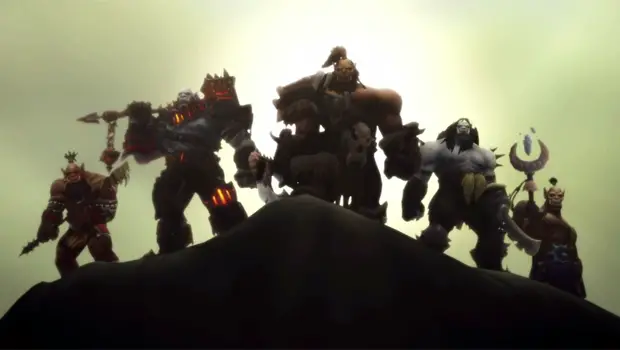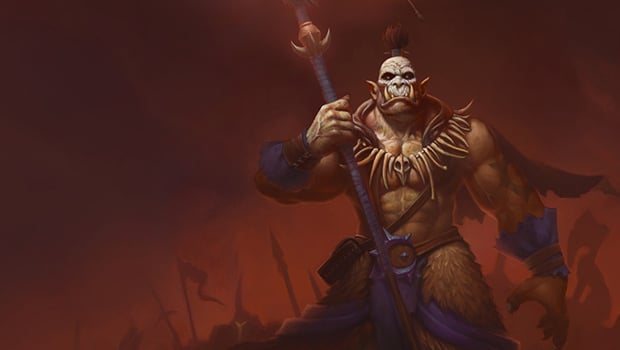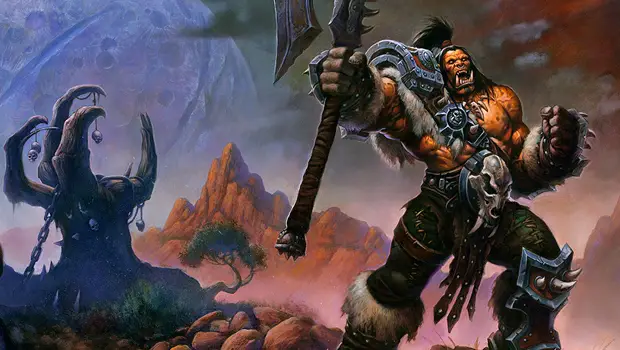Know Your Lore: Ner’zhul, Gul’dan, and Grommash Hellscream

What was Kairoz looking for? That’s the question that’s been bothering me all expansion long — the bronze dragon clearly intended to do something when he arrived on Draenor. He clearly intended for Garrosh to go speak with Grommash Hellscream and warm the orc to the idea of an orcish Horde. But for what purpose, exactly? In the final few glimpses we get of Kairoz during the legendary quest chain, he says that he “would be Infinite,” suggesting he was in fact allied with the Infinite Dragonflight, but for what reason? What did they offer that he so desperately wanted?
Last week, we took a look at three of Draenor’s warlords, and how our original version of these orc chieftains compared to their Draenor counterparts. This week, we’re taking a look at the final three, perhaps the most and least changed of all — Ner’zhul, Gul’dan, and Grommash Hellscream. By examining these differences, maybe we can begin to pick apart just what Kairoz was looking for when he sent Garrosh through time. And maybe we can put on our tinfoil hats and try to unravel just what, exactly, Kairoz originally intended to do before his plans were abruptly ended with his death.
Today’s Know Your Lore contains some speculation based on known material. These speculations are merely theories and shouldn’t be taken as fact or official lore.
 Ner’zhul
Ner’zhul
Our universe: Ner’zhul was in a way the Warchief before there was an official Warchief — the spiritual leader of the Horde, respected by all, renowned for his wisdom, and easily one of the most popular orcs in all of the clans, more so than even Blackhand. But Ner’zhul craved power, and it proved to be his eventual downfall — and the downfall of Draenor itself. At some point Ner’zhul lost his beloved mate, Rulkan, and years later he was contacted by her spirit — or so he thought. In fact, it was Kil’jaeden in disguise, and the Deceiver managed to use the guise to convince Ner’zhul that the draenei were an imminent threat that needed to be dealt with. Because of Ner’zhul’s popularity and influence, it was only a matter of time before the orcs turned on the draenei in earnest, convinced of their alleged betrayal by Ner’zhul. But the spirits that once spoke to Ner’zhul would speak to him no longer, and after visiting Oshu’gun, Ner’zhul discovered why — to his horror, he had been betrayed, and in turn had betrayed the orcish race and perhaps doomed them to a dark path from which there was no escape. Although Ner’zhul was determined to tell the truth, he was stopped by the betrayal of his apprentice, Gul’dan — and Kil’jaeden stripped him of his powers and imprisoned him, forcing him to watch the dark demise of his race.
After the Second War, Ner’zhul was caught in the blast when the Dark Portal was destroyed by the Alliance. For two years he recovered, seeing visions of death, perhaps his own — and after those two years were up, he was approached by the death knight Teron Gorefiend, who had a plan — open new portals to new worlds, ripe and waiting for the Horde to conquer. Ner’zhul agreed, and set about gathering the items need to do so — the first, the skull of his former student, Gul’dan. Gul’dan may have been dead, but his spirit still lingered, whispering promises of untold power to Ner’zhul and slowly driving the orc mad. When at last the ritual was performed and the portals were opened, Ner’zhul forgot about the Horde and instead embraced the idea of ultimate power, ducking through a portal and leaving the Horde behind. On the other side, Kil’jaeden was waiting for him. He tore Ner’zhul apart, seizing his spirit and demanding his service — and once he had it, he bound Ner’zhul’s spirit to the Helm of Domination, trapped it inside the Frozen Throne and the one-revered shaman became the Lich King.
Draenor: There are some major, major differences with Ner’zhul’s story on Draenor. First is the fact that Rulkan is alive — which means that either Kil’jaeden never spoke to Ner’zhul in the first place, or he chose a different guise, one that Ner’zhul apparently turned down. The Shadowmoon Clan were on friendly enough terms with the draenei of Shadowmoon Valley, until the day that Grommash Hellscream arrived and demanded that Ner’zhul demonstrate some sort of power that would be useful to the Iron Horde, or see his entire clan slain. In order to prevent the extinction of his clan, Ner’zhul tapped into the powers of the Dark Star, long forbidden to the Shadowmoon, using the void itself to demonstrate what kind of power he could bring to the Iron Horde.
What’s the biggest difference between the other Ner’zhul, and the one presented on Draenor? Reputation. Ner’zhul, by all appearances, is not the revered, wise spiritual leader of the orcish clans like he was in our world. He doesn’t have the immediate approval or respect of the other clans. He may have wished for some kind of unity, but he never acted upon that wish. He was apparently never contacted by Kil’jaeden. And he never had a problem with the draenei — his people lived peacefully side by side with the draenei and had no apparent issues at all. Rulkan, his wife, was even someone that Prophet Velen considered a friend.
 Gul’dan
Gul’dan
Our universe: Gul’dan was a noteworthy shaman — so noteworthy, in fact, that he became the favored apprentice of Ner’zhul. Gul’dan was also one other very important thing: power hungry, something that pretty much fueled every decision he ever made. If there was more power in it for him, then he was all for making it happen. Those who got in the way of Gul’dan’s quest for power soon found themselves removed from the equation, one way or another — Ner’zhul was the elder shaman, but the moment an opportunity arose for Gul’dan to betray his master, he did so. He gladly took the gifts the Burning Legion offered, willingly formed the Horde to act as servants for the Legion in exchange for, you guessed it, even more power. The Horde was his tool, the Shadow Council was his tool, Blackhand was his tool, but Gul’dan made a fatal mistake in trying to use the Legion as his tool as well.
When Medivh was about to be cut down in Karazhan during the First War, Gul’dan tried to intervene, looking for the location of the Tomb of Sargeras, a place that contained even more power, power that was promised to Gul’dan in exchange for his help getting the orcs to Azeroth. When Medivh was killed, it threw Gul’dan into a coma, and that gave Orgrim Doomhammer the perfect opening to kill Blackhand, claim the Horde as his own, systematically murder the Shadow Council, and wait patiently for Gul’dan to wake up. Upon awakening, Gul’dan agreed to serve Doomhammer in exchange for his miserable life — but the moment he had the opportunity, he deserted the Horde and headed for the Tomb of Sargeras, intend on finding that source of power. He never found it. Instead, he found a mob of insane demons who proceeded to tear him to shreds. Yet even after his death, Gul’dan’s soul lingered on in his skull, whispering dark secrets and promises to those who dared hold it. This included his old master, Ner’zhul.
Draenor: Obviously we don’t have Gul’dan’s skull to worry about in this timeline. But as for the rest … Gul’dan is in fact eerily similar to his counterpart from our timeline, in regards to his lust for power. We don’t know if he ever served as Ner’zhul’s favored apprentice, but we do know that in this timeline, Gul’dan was contacted directly by the Burning Legion, with no apparent involvement on Ner’zhul’s part at all. He formed the Shadow Council of his own accord, drank Mannoroth’s blood of his own accord, and sought to unite the clans into the Horde for Kil’jaeden — an act that failed miserably thanks to the interference of Garrosh Hellscream. And Gul’dan is just as cunning as he was in our timeline, biding his time, letting us systematically dismantle the Iron Horde until they turn back to him and his bucket of demon Koolaid because they’ve simply run out of options.
In fact, the biggest difference between this Gul’dan and our own is that the Burning Legion opened a direct line to him. How did they find him? How did they know that he would be the best point of contact?
 Grommash Hellscream
Grommash Hellscream
Our universe: Grommash Hellscream came into leadership of the Warsong clan through mysterious circumstances and at a young age. But he ruled with a ferocity that could not be challenged. Although stubborn, Grom was also fiercely loyal to his people, immediately jumping on the idea of war with the draenei when Ner’zhul broached the subject and eagerly leading raids against draenei settlements. But of course Grom’s most famous deed was stepping forward to be the first to drink the blood of Mannoroth — and the rest of the clans quickly followed his zealous example. But the Warsong stayed behind on Draenor when the Horde first charged through the Dark Portal, only traveling through when tasked to retrieve items of magical power by Ner’zhul, after the Horde’s defeat in the Second War. The Warsong attacked Nethergarde Keep, and retreated to defend the Dark Portal, but once Khadgar destroyed it they found themselves stranded on Azeroth.
And Azeroth was not kind. The Horde had been defeated in the Second War, the orcs thrown into internment camps, so Grom wisely led the Warsong into hiding in the wilds of Lordaeron. Older now, and wiser, Grom realized the enormity of what he had done, and struggled to fight the lethargy that plagued his people. And that’s when Thrall arrived, and brought with him a spark of hope that fueled Hellscream into action once more. He helped Thrall free the orcs and form a new Horde, followed him to Kalimdor, but once again found himself unable to resist temptation. In Ashenvale, he discovered a fountain of blood, and desperate to save his forces and his clan from the threat of Cenarius, he drank once again. Fueled with demonic power, he killed Cenarius, but Mannoroth gleefully revealed himself and took the orcs under his control. Thrall managed to free them again, and both he and Hellscream went forth in search of Mannoroth — and the rest is very well known. They fought Mannoroth, and Hellscream gave his life to kill the pit lord, freeing not just himself, but everyone from the blood curse for good.
Draenor: Fun story — we don’t actually know much about the Hellscream of this Draenor. For all he’s been touted as the leader of the Iron Horde, he’s been largely absent until recently, presumably working behind the scenes. What we have seen in various short stories, comics, and the few moments we’ve witnessed his actions in game is a leader who is strong, proud, and fiercely devoted to his people. But his pride and his fierce nature nearly brought his clan down around his ears in their constant skirmishes with the ogres, and he lost his mate, Golka, as a result — before she could bear him the son he never had in this timeline. When Garrosh arrived to meet with Grom, it was a far more subdued Grom, haunted by guilt — guilt over nearly leading his clan into ruin, guilt over not giving Golka the warrior’s death she had rightfully earned. And there was one other thing Grom had, perhaps even more so than our version of the warlord: tenacity. He survived torture at the hands of an ogre warlord, and despite being starved to the point of emaciation, still managed to rip the ogre’s throat out when he got too close. Despite his perceived weaknesses, he lived on — and so too, did the Warsong.
It’s that tenacity that links our Grom to the Grommash Hellscream of Draenor. But this version is arguably stronger than our own — he listened to Garrosh, heeded his warning and refused the blood of Mannoroth, proudly proclaiming that his people would never be slaves. He rallied the orc clans together into the indomitable Iron Horde, led the charge against Azeroth. And when the Iron Horde fell around his ears and Gul’dan showed his face again, offering Grommash a second chance at all the power a demonic drink could offer, Grommash turned him down again. Because oddly enough, this Grommash has a noble heart — a giant’s heart, as his name suggests — one that will not bow or bend for anyone. Will his stubborn tenacity eventually lead to his downfall? Perhaps.
Tinfoil Hats
Let’s think about this for a minute, here, and indulge in some speculation. When Kairoz arrived on Draenor, he clearly believed he was in control and he was calling the shots. He arranged to free Hellscream and bring him to Draenor, saying that it was the best possible place for his plans to come to fruition. It wasn’t a mirror image — but that was possibly what made it perfect, the fact that some key things had changed and shifted the course of what happened on the world. The biggest changes? Garrosh was never born. That’s a given, makes it a lot easier to speak to Grommash as a stranger than with some awkward explanation about being a son from another timeline.
My plans require a few… favorable conditions, and we’ll find them here. This is the perfect timeway for us. Not a perfect mirror image, but perfect nonetheless.
And beyond that, there were the changes to the clans themselves. Ner’zhul didn’t hold that seat of power and respect that had all the orc clans willingly follow him against the draenei. Because of this, perhaps Kairoz assumed that the Burning Legion would be a non-factor — Rulkan was still alive, therefore Kil’jaeden had never appeared as her to Ner’zhul, therefore the Legion was simply … absent. Kairoz never got a chance to find out about Gul’dan — and perhaps he didn’t even bother looking to see if Gul’dan had been offered power, assuming that without Ner’zhul’s first point of contact, that contact never happened. What does this leave him with? A lot of orcs with no real guidance to speak of, just waiting to be ushered into one domineering force — a force that Kairoz would then presumably control.
What’s weird about this is that when Chromie explains the situation in War Crimes, she describes the two factions of bronze dragons as being divided in terms of what to do, now that Nozdormu and most of the flight have lost their powers. Some are content to let the mortals take over, assisting where necessary. Some think that since their task has been fulfilled, they are free to build a “better future” — one of their own design. Who defines what is better? That’s the problem. And maybe Kairoz had some kind of demented definition of “better” that involved dragons taking over again. Maybe he wanted the mortals of Azeroth firmly under his control. But he ran into one smaller problem before he could hit the really big problem — Garrosh killed him.
The really big problem? That’s the Burning Legion. And what’s confusing right now is exactly how these creatures can still exist. Clearly Archimonde died in our timeline, we killed him at Hyjal in the Third War. Yet clearly he exists in Hellfire Citadel, and the dungeon journal states that he “reached across space and time to ensure that the invasion of Azeroth proceeds as planned.”
Hold on now. Back up a minute. The invasion of Azeroth? Wasn’t that, you know, Grommash and the Iron Horde’s idea, suggested by Garrosh? Wasn’t Gul’dan originally being used as a glorified battery for the Dark Portal when we showed up, imprisoned and helpless until we set him and his Shadow Council cronies free? Which Azeroth did Archimonde intend to invade? Ours? Didn’t we beat him already? How does he know about our world’s existence?
Maybe Kairoz’s plans involved talking to a few more influential people than Garrosh, Chromie, Khadgar, or even Wrathion could have guessed. We’ll have to wait and see to find out.
Please consider supporting our Patreon!
Join the Discussion
Blizzard Watch is a safe space for all readers. By leaving comments on this site you agree to follow our commenting and community guidelines.
 @Shadesogrey
@Shadesogrey




